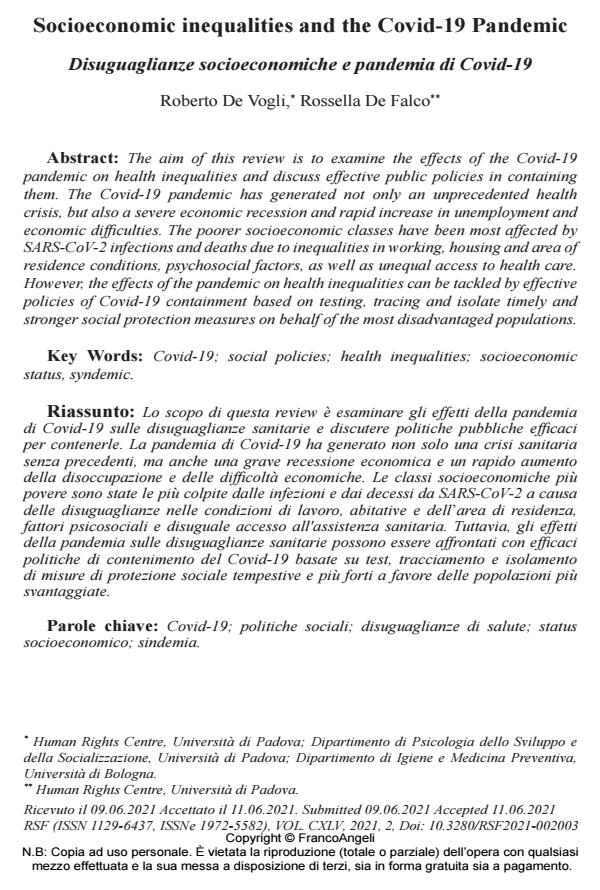Socioeconomic inequalities and the Covid-19 Pandemic
Titolo Rivista RIVISTA SPERIMENTALE DI FRENIATRIA
Autori/Curatori Roberto De Vogli, Rossella De Falco
Anno di pubblicazione 2021 Fascicolo 2021/2
Lingua Inglese Numero pagine 11 P. 25-35 Dimensione file 160 KB
DOI 10.3280/RSF2021-002003
Il DOI è il codice a barre della proprietà intellettuale: per saperne di più
clicca qui
Qui sotto puoi vedere in anteprima la prima pagina di questo articolo.
Se questo articolo ti interessa, lo puoi acquistare (e scaricare in formato pdf) seguendo le facili indicazioni per acquistare il download credit. Acquista Download Credits per scaricare questo Articolo in formato PDF

FrancoAngeli è membro della Publishers International Linking Association, Inc (PILA)associazione indipendente e non profit per facilitare (attraverso i servizi tecnologici implementati da CrossRef.org) l’accesso degli studiosi ai contenuti digitali nelle pubblicazioni professionali e scientifiche
The aim of this review is to examine the effects of the Covid-19 pandemic on health inequalities and discuss effective public policies in containing them. The Covid-19 pandemic has generated not only an unprecedented health crisis, but also a severe economic recession and rapid increase in unemployment and economic difficulties. The poorer socioeconomic classes have been most affected by SARS-CoV-2 infections and deaths due to inequalities in working, housing and area of residence conditions, psychosocial factors, as well as unequal access to health care. However, the effects of the pandemic on health inequalities can be tackled by effective policies of Covid-19 containment based on testing, tracing and isolate timely and stronger social protection measures on behalf of the most disadvantaged populations.
Lo scopo di questa review è esaminare gli effetti della pandemia di Covid-19 sulle disuguaglianze sanitarie e discutere politiche pubbliche efficaci per contenerle. La pandemia di Covid-19 ha generato non solo una crisi sanitaria senza precedenti, ma anche una grave recessione economica e un rapido aumento della disoccupazione e delle difficoltà economiche. Le classi socioeconomiche più povere sono state le più colpite dalle infezioni e dai decessi da SARS-CoV-2 a causa delle disuguaglianze nelle condizioni di lavoro, abitative e dellʼarea di residenza, fattori psicosociali e disuguale accesso all'assistenza sanitaria. Tuttavia, gli effetti della pandemia sulle disuguaglianze sanitarie possono essere affrontati con efficaci politiche di contenimento del Covid-19 basate su test, tracciamento e isolamento di misure di protezione sociale tempestive e più forti a favore delle popolazioni più svantaggiate.
Parole chiave:Covid-19; politiche sociali; disuguaglianze di salute; status socioeconomico; sindemia.
- Short-term Impact of Financial Support to Inner Areas Gianluca Monturano, Giuliano Resce, Marco Ventura, in Italian Economic Journal /2025
DOI: 10.1007/s40797-025-00313-w
Roberto De Vogli, Rossella De Falco, Socioeconomic inequalities and the Covid-19 Pandemic in "RIVISTA SPERIMENTALE DI FRENIATRIA" 2/2021, pp 25-35, DOI: 10.3280/RSF2021-002003